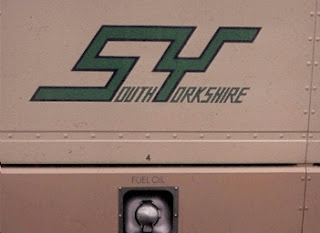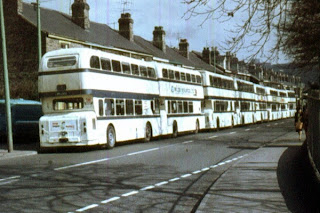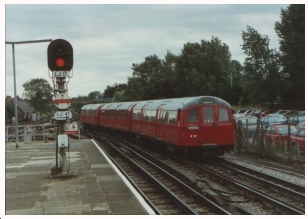--------------------------------------------------------------------
Halloween
The eve of all All Hallows Day aka All Saints Day.
On November 1st, many Christians focus on "all the saints", all
the folk who commit their lives to Christ, to Good and to Right.
Traditionally on the day before, there was a folksy, semi-pagan
but fearfully urgent desire to get rid of all evil by using ...
... scary imagery.
Commercial considerations have turned Halloween
into a day of rejoicing in the world of evil and the occult.
Today, when there is so much that is intrinsically bad,
should we be encouraging this "rejoicing" by our children?
--------------------------------------------------------------------
Back to Buses!Wormhole Revealed in Sheffield.
A guest blog from Professor Brian Cox
Physicists have long since proved, mathematically, that wormholes should exist; but finding evidence for one in reality has been less successful. Until now, that is.
So what is a wormhole? Without entering the esoteric field of theoretical physics, think of a wormhole as a tunnel through space and time. A spacecraft would enter the tunnel, for example, in our local galaxy (at "A" in the diagram), and be transported instantly and beautifully into a completely different part of our universe or, indeed, into a completely different universe (point "B") or backwards or forwards in time!
Now here is the exciting part! Substitute the Sheffield suburb of Shiregreen for "A", and the district known as Highfield for "B" and here we have the first tangible evidence for a live and active wormhole.
The investigation begins here at an unassuming bus stop opposite platform A of Sheffield Interchange.
From here you can catch a 47 or 48 bus northwards to Shiregreen, passing through Pitsmoor, Fir Vale and Firth Park.
This is a frequent cross-city route, running to Herdings in the south of the City. But our desire is to travel north and we can use Travel South Yorkshire's stunning on-line services to check departure times from this particular stop.
There is a pretty clickable plan to help.
And up pops a list of places served by route 47. All is well on this list until you get to Shiregreen terminus; but it's the next stop listed that reveals the location of the wormhole. Once the bus leaves Shiregreen you would expect it to return to City. But it doesn't. The bus next appears at ...
... Highfield, having leapt invisibly, beautifully and instantly from a northern suburb to a location south of the City centre ...
... en route to Herdings and, distorted by the space-time continuum, now travelling in the opposite direction!
Researchers are currently seeking to find the Shiregreen wormhole here ...
... at the Butterthwaite Road Junction but sensors show that the other (southern) end is in the basement of Highfield Library, with buses materialising via the now-closed public conveniences.
Doubtless this discovery with mean that we have to rewrite our textbooks and the universe will seem even more beautiful but will never be the same again.
fbb adds his comment.
Now that the news has broken, the BBC has commissioned a full length Horizon programme which Prof Cox will be presenting; including lots of shots of his gazing wistfully into the setting sun whilst "significant" background music plays rather too loudly for comfort.
Nevertheless a truly remarkable discovery.
Or it could be that Travel South Yorkshire have messed up their data management, yet again? Surely not?
For the record, it would take one hour and 28 minutes to get from stop FS5 to Herdings via Shiregreen. OR you could walk across the road to Platform A, stop A2, and take 23 minutes. Oddly, the wormhole route does not seem to save much time.
Next blog : due Tuesday November 1st
The investigation begins here at an unassuming bus stop opposite platform A of Sheffield Interchange.
From here you can catch a 47 or 48 bus northwards to Shiregreen, passing through Pitsmoor, Fir Vale and Firth Park.
This is a frequent cross-city route, running to Herdings in the south of the City. But our desire is to travel north and we can use Travel South Yorkshire's stunning on-line services to check departure times from this particular stop.
There is a pretty clickable plan to help.
And up pops a list of places served by route 47. All is well on this list until you get to Shiregreen terminus; but it's the next stop listed that reveals the location of the wormhole. Once the bus leaves Shiregreen you would expect it to return to City. But it doesn't. The bus next appears at ...
... Highfield, having leapt invisibly, beautifully and instantly from a northern suburb to a location south of the City centre ...
... en route to Herdings and, distorted by the space-time continuum, now travelling in the opposite direction!
Researchers are currently seeking to find the Shiregreen wormhole here ...
... at the Butterthwaite Road Junction but sensors show that the other (southern) end is in the basement of Highfield Library, with buses materialising via the now-closed public conveniences.
Doubtless this discovery with mean that we have to rewrite our textbooks and the universe will seem even more beautiful but will never be the same again.
fbb adds his comment.
Now that the news has broken, the BBC has commissioned a full length Horizon programme which Prof Cox will be presenting; including lots of shots of his gazing wistfully into the setting sun whilst "significant" background music plays rather too loudly for comfort.
Nevertheless a truly remarkable discovery.
Or it could be that Travel South Yorkshire have messed up their data management, yet again? Surely not?
For the record, it would take one hour and 28 minutes to get from stop FS5 to Herdings via Shiregreen. OR you could walk across the road to Platform A, stop A2, and take 23 minutes. Oddly, the wormhole route does not seem to save much time.
Next blog : due Tuesday November 1st






















































